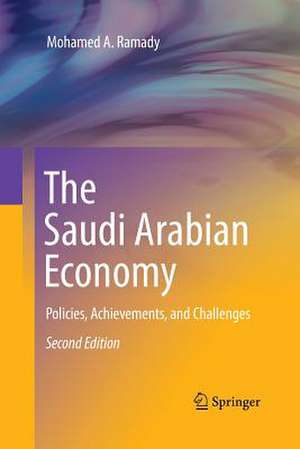The Saudi Arabian Economy: Policies, Achievements, and Challenges
Autor Mohamed A. Ramadyen Limba Engleză Paperback – 19 oct 2014
| Toate formatele și edițiile | Preț | Express |
|---|---|---|
| Paperback (1) | 711.11 lei 6-8 săpt. | |
| Springer Us – 19 oct 2014 | 711.11 lei 6-8 săpt. | |
| Hardback (1) | 755.35 lei 6-8 săpt. | |
| Springer Us – 17 sep 2010 | 755.35 lei 6-8 săpt. |
Preț: 711.11 lei
Preț vechi: 836.60 lei
-15% Nou
Puncte Express: 1067
Preț estimativ în valută:
136.07€ • 142.43$ • 113.25£
136.07€ • 142.43$ • 113.25£
Carte tipărită la comandă
Livrare economică 31 martie-14 aprilie
Preluare comenzi: 021 569.72.76
Specificații
ISBN-13: 9781489999603
ISBN-10: 1489999604
Pagini: 536
Ilustrații: XXII, 512 p.
Dimensiuni: 155 x 235 x 28 mm
Greutate: 0.81 kg
Ediția:2nd ed. 2010
Editura: Springer Us
Colecția Springer
Locul publicării:New York, NY, United States
ISBN-10: 1489999604
Pagini: 536
Ilustrații: XXII, 512 p.
Dimensiuni: 155 x 235 x 28 mm
Greutate: 0.81 kg
Ediția:2nd ed. 2010
Editura: Springer Us
Colecția Springer
Locul publicării:New York, NY, United States
Public țintă
Upper undergraduateCuprins
The Setting.- Overview.- The Development Process.- Reforms and Economic Planning.- Public Finance.- The Financial Sector.- Saudi Arabian Monetary Agency (SAMA) and Monetary Policy.- The Financial Markets.- The Saudi Capital Market.- The Domestic Sector.- The Private Sector: Globalization Challenges.- The Energy Sector.- The Foreign Sector.- Foreign Trade: Changing Composition and Direction.- Saudi Arabia and the WTO.- Key Challenges.- Privatization and Foreign Direct Investment.- Population and Demographics: Saudization and the Labour Market.- Education: A Tool for a Knowledge-Based Economy.- Saudi Arabia’s Global Relations: GCC and Beyond.- Conclusion.- The Challenges Ahead.
Notă biografică
Mohamed Ramady is Visiting Associate Professor at the Department of Finance and Economics, King Fahd University of Petroleum and Minerals. His main research interests are the economies of the Middle East and Saudi Arabia in particular, as well as money and banking. He also held senior positions with international financial institutions in the Arabian Gulf and Europe.
Textul de pe ultima copertă
The Saudi Arabian economy has changed almost beyond recognition since the oil boom days of the 1980s, and the Kingdom itself has changed too economically, socially, and demographically. In the second edition of The Saudi Arabian Economy, Mohamed Ramady uses several overlapping themes to establish and develop a framework for studying the fundamental challenges to the Saudi economy. Particular attention is paid to the benefits of short-term planning and long-term diversification intended to shield the economy from potentially de-stabilizing oil price fluctuations and the pace and diversity of domestic reforms.The author examines the core strengths and evolution of various financial institutions and the Saudi stock market in the face of globalization, before analyzing the private sector in detail. Topics discussed include:•The hydrocarbon and minerals sector, including the emergence of the competitive petrochemical sector•The impact of small and medium sized businesses and the evolving role of “family” businesses •The growing role of women in the Saudi economy•The role of privatization and FDI as engines of change and the position of public-private-partnerships •The establishment of a foundation for a knowledge-based economyFinally, the author offers an analysis of the key challenges facing the Saudi economy, paying particular attention to the potential costs and benefits of globalization, and membership in the WTO. Employment, education, economic and social stability, and Saudi Arabia’s place in the Gulf Cooperation Council, as well as Saudi Arabia’s evolving strategic economic relations with China and other countries are offered as keys to the consensus building needed to ensure the Kingdom’s healthy economic future. Mohamed Ramady is Visiting Associate Professor at the Department of Finance and Economics, King Fahd University of Petroleum and Minerals. His main research interests are the economies of the Middle East and SaudiArabia in particular, as well as money and banking. He also held senior positions with international financial institutions in the Arabian Gulf and Europe.
Caracteristici
Broadest, most up-to-date text on the Saudi economy Pays particular attention to sensitive structural social issues, finance and capital market development, technology transfer, the effect of gender issues on development, and globalization Accessible to undergraduates Pedagogy includes graphs; tables; end-of-chapter summaries, questions, and discussion points; chapter objectives; and discussion boxes Includes supplementary material: sn.pub/extras















